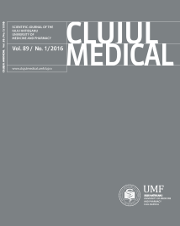Prevalence and predictors of non-alcoholic fatty liver disease as defined by the fatty liver index in a type 2 diabetes population
DOI:
https://doi.org/10.15386/cjmed-544Keywords:
nonalcoholic fatty liver disease, fatty liver index, risk factors, type 2 diabetes.Abstract
Background and aims. We aimed to study prevalence and the predictive factors of non-alcoholic fatty liver disease (NAFLD) defined by the fatty liver index (FLI) in type 2 diabetic patients (T2DM).
Methods. Three hundred and eighty-one T2DM outpatients who regularly attended a Consulting Clinic in Cluj were retrospectivelly included. FLI, a surrogate steatosis biomarker based on body mass index (BMI), waist circumference (WC), triglycerides (TGL) and gammaglutamyl-transferase (GGT) was used to assess NAFLD in all patients. Anthropometric and biochemical parameters were measured. Hepatic steatosis (HS) was evaluated by ultrasonography.
Results. NAFLD-FLI (defined as FLI >60) was correlated with HS evaluated by ultrasound (r=0.28; p<0.001). NAFLD-FLI was detected in 79% of T2DM. The prevalence of obesity in NAFLD-FLI patients was 80%. Of the patients with normal alanine aminotransferase (ALAT), 73.8 % had NAFLD. At univariate analysis, NAFLD-FLI was correlated with age (r= -0.14; p=0.007), sex (r=0.20; p<0.001), LDL cholesterol (r=0.12; p=0.032), HDL cholesterol (r = -0.13; p=0.015), ALAT (r=0.20; p<0.001) and ASAT (r=0.19; p<0.001). At multiple regression analysis, sex, ALAT and LDL-cholesterol were independent predictors of NAFLD-FLI. After logistic regression model, ALAT, LDL-cholesterol, HOMA-IR were good independent predictors of NAFLD-FLI.
Conclusions. NAFLD-FLI could be useful to identify NAFLD in T2DM patients. Subjects with T2DM had a high prevalence of NADLD-FLI even with normal ALAT levels . Our findings showed that sex, ALAT, LDL cholesterol and IR were significant and independent factors associated with the presence of NAFLD in T2DM subjects.
Downloads
Published
How to Cite
Issue
Section
License
The authors are required to transfer the copyright of the published paper to the journal. This is done by agreeing to sign the Copyright Assignment Form. Whenever the case, authors are also required to send permissions to reproduce material (such as illustrations) from the copyright holder.

The papers published in the journal are licensed under a Creative Commons Attribution-NonCommercial-NoDerivatives 4.0 International License.

